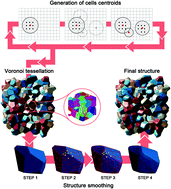Compression simulations of plant tissue in 3D using a mass-spring system approach and discrete element method
Abstract
A hybrid model based on a mass-spring system methodology coupled with the discrete element method (DEM) was implemented to simulate the deformation of cellular structures in 3D. Models of individual cells were constructed using the particles which cover the surfaces of cell walls and are interconnected in a triangle mesh network by viscoelastic springs. The spatial arrangement of the cells required to construct a virtual tissue was obtained using Poisson-disc sampling and Voronoi tessellation in 3D space. Three structural features were included in the model: viscoelastic material of cell walls, linearly elastic interior of the cells (simulating compressible liquid) and a gas phase in the intercellular spaces. The response of the models to an external load was demonstrated during quasi-static compression simulations. The sensitivity of the model was investigated at fixed compression parameters with variable tissue porosity, cell size and cell wall properties, such as thickness and Young's modulus, and a stiffness of the cell interior that simulated turgor pressure. The extent of the agreement between the simulation results and other models published is discussed. The model demonstrated the significant influence of tissue structure on micromechanical properties and allowed for the interpretation of the compression test results with respect to changes occurring in the structure of the virtual tissue. During compression virtual structures composed of smaller cells produced higher reaction forces and therefore they were stiffer than structures with large cells. The increase in the number of intercellular spaces (porosity) resulted in a decrease in reaction forces. The numerical model was capable of simulating the quasi-static compression experiment and reproducing the strain stiffening observed in experiment. Stress accumulation at the edges of the cell walls where three cells meet suggests that cell-to-cell debonding and crack propagation through the contact edge of neighboring cells is one of the most prevalent ways for tissue to rupture.



 Please wait while we load your content...
Please wait while we load your content...